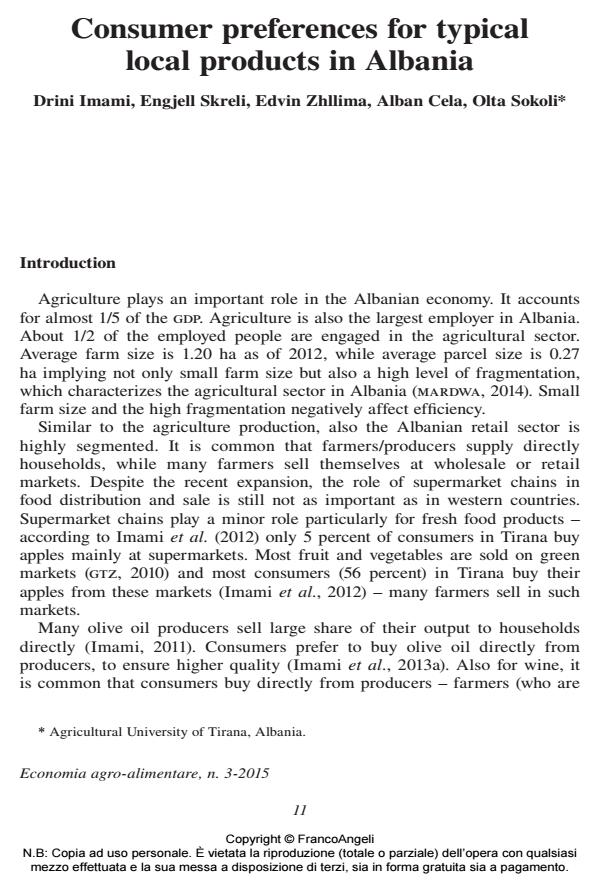Consumer preferences for typical local products in Albania
Journal title ECONOMIA AGRO-ALIMENTARE
Author/s Drini Imami, Engjell Skreli, Edvin Zhllima, Alban Cela, Olta Sokoli
Publishing Year 2015 Issue 2015/3
Language English Pages 19 P. 11-29 File size 206 KB
DOI 10.3280/ECAG2015-003002
DOI is like a bar code for intellectual property: to have more infomation
click here
Below, you can see the article first page
If you want to buy this article in PDF format, you can do it, following the instructions to buy download credits

FrancoAngeli is member of Publishers International Linking Association, Inc (PILA), a not-for-profit association which run the CrossRef service enabling links to and from online scholarly content.
Albania has the potential to develop quality products given its cultural, climatic and territorial diversity. Moreover, consumers’ sensitivity to the origin of agrofood products, the huge variety of products, the growing integration of farms into the market, combined with on-going improvements in the legal and institutional framework regarding Protected Designation of Origin (pdo) and Protected Geographical Indications (pgi) indicate that these quality schemes are valid options for the maintenance of the agricultural sector in Albania, especially in mountainous areas. This study is based on a structured survey including 269 face-to-face interviews which were conducted in Tirana during summer 2013. According to the study results, most consumers’ choice of products is based on their origin (domestic versus imported), with a preference for domestic products. Also, within the domestic product group, there are significant differences in perceptions based on which region of Albania they were produced in - most interviewees stated that the region/ area of origin is either important or very important when choosing to buy Albanian products. There is a clear pattern of regional preferences for various food products, including most notably cheese. Based on association of typical product to specific regions, Protected Designation of Origin or Protected Geographical Indications can be promoted.
Keywords: Consumer preferences, typical products, Albania
Jel codes: Q13
- Finding the right price: supply chain contracts as a tool to guarantee sustainable economic viability of organic farms Elena Viganò, Martina Maccaroni, Selene Righi, in International Food and Agribusiness Management Review /2022 pp.411
DOI: 10.22434/IFAMR2021.0103 - Consumer attitudes towards organic food in the Western Balkans - the case of Albania Drini Imami, Engjell Skreli, Edvin Zhllima, Catherine Chanb, in ECONOMIA AGRO-ALIMENTARE 2/2017 pp.245
DOI: 10.3280/ECAG2017-002004 - Analysis of urban consumer preferences for honey in the context of a transition economy – A case study for Albania Alban Cela, Edvin Zhllima, Drini Imami, Engjell Skreli, Maurizio Canavari, Catherine Chan, in Die Bodenkultur: Journal of Land Management, Food and Environment /2019 pp.237
DOI: 10.2478/boku-2019-0021 - Assessing consumer preferences and willingness to pay for organic tomatoes in Albania: a conjoint choice experiment study Engjell Skreli, Drini Imami, Catherine Chan, Maurizio Canavari, Edvin Zhllima, Ergent Pire, in Spanish Journal of Agricultural Research /2017 pp.e0114
DOI: 10.5424/sjar/2017153-9889 - Social capital as a determinant for raising ecosystem services awareness - an application to an Albanian pastoral ecosystem Elena Kokthi, Elda Muço, Mélanie Requier-Desjardins, Fatmir Guri, in Landscape Online /2021 pp.1
DOI: 10.3097/LO.202195
Drini Imami, Engjell Skreli, Edvin Zhllima, Alban Cela, Olta Sokoli, Consumer preferences for typical local products in Albania in "ECONOMIA AGRO-ALIMENTARE" 3/2015, pp 11-29, DOI: 10.3280/ECAG2015-003002